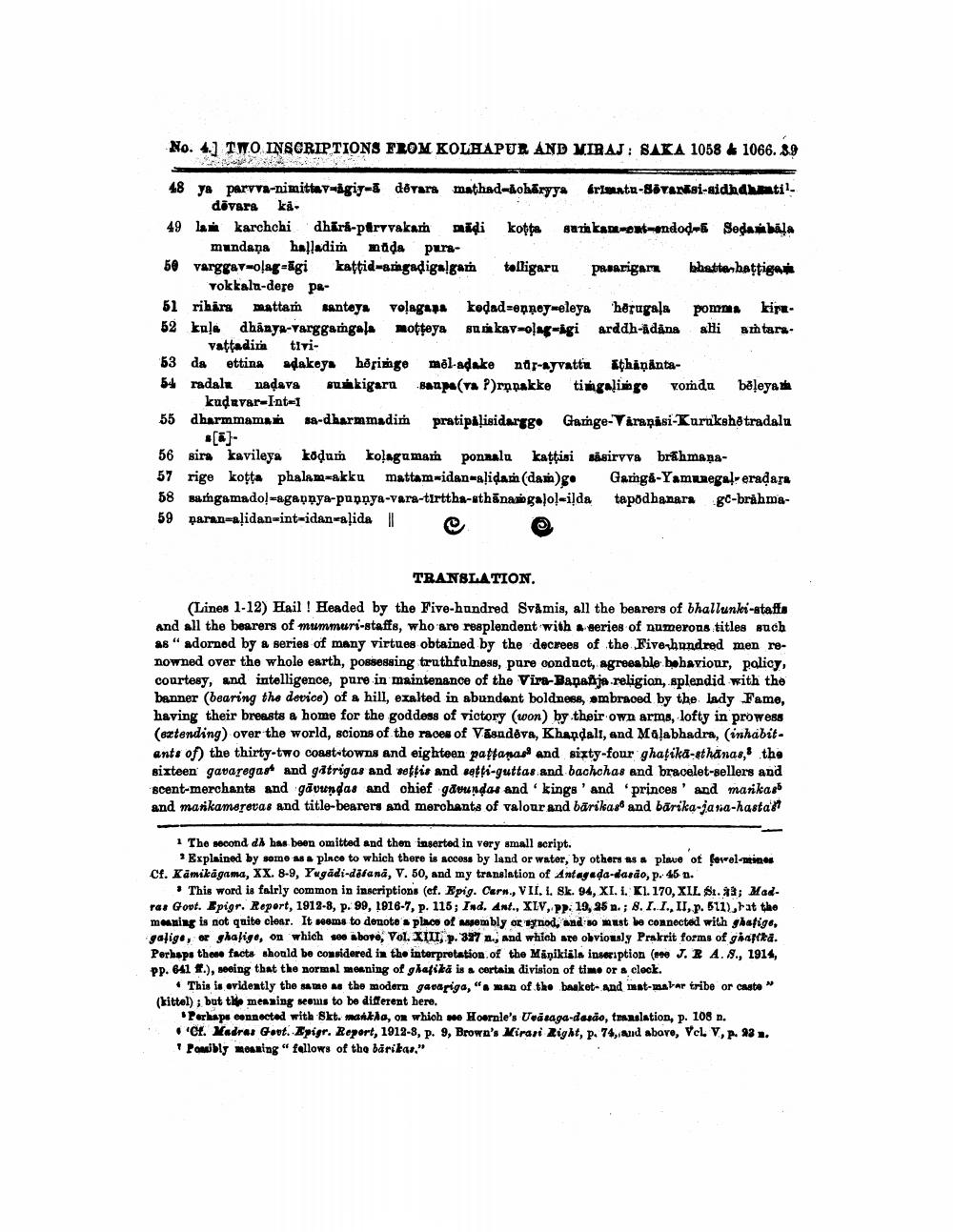________________
No. 4.] TWO INSCRIPTIONS FROM KOLHAPUR AND WIRAJ: SAKA 1058 & 1066. 89
2
48 ya parvva-nimittav-igiy-idoara mathad-dokäryya erimntu-Sirenisi-nidhdhammtil
divara ka49 lai karchchi dhird-parvvakarh midi kopta satin kan ont-endod- Sedati bāla
mundana halladin nada pura50 varggav=o!ag-Igi kattid-amgadiga!gam tolligaru pasarigaru bhatten hattige
vokkala-dere pe51 ribära mattań santoya volagapa kedad=eppeyweleya hörugala poma kiru52 kula dhanya-varggangalan motteya sunkav=o!ag-igi arddh-adana ali attars.
vattadiria tivi53 da ettina adakeya hôringe mél-adake nar-avattu Athiņänta54 radalu nadava suákigaru saape(va ?)rņpakke tingalinge vomdı bəleya
kadaver-Inte1 55 dharmmaman sa-dharmmadim pratipiļisidarego Gange-Tirapisi-Kurukshatradalu
56 sira kavileya kodum kolaguman ponakla kattisi säsirvva brahmana57 rige kotta phalamuakku mattam-idan-alidam (dasin)ge Ganga-Yamunegalreradara 58 samgamado!=agapnya-punnya-vara-tirttha-sthānangaļo!-iļda tapodhanara gc-brahma59 paran=aļidan-int-idan-alida ||
TRANSLATION. (Lines 1-12) Hail ! Headed by the Five-hundred Svåmis, all the bearers of bhallunki-atatta and all the bearers of mummuri-staffs, who are resplendent with a series of numerous titles such as " adorned by a series of many virtues obtained by the decrees of the Five hundred men renowned over the whole earth, possessing truthfulness, pure conduct, agreeable behaviour, palicy, courtesy, and intelligence, pure in maintenance of the Vira-Banaħja religion, splendid with the banner (bearing the device) of a hill, exalted in abundant boldness, ambraced by the lady Fame, having their breasts a home for the goddess of victory (won) by their own arms, lofty in prowess (extending) over the world, scions of the races of Vasudeva, Khapdali, and Malabhadra, (inhabit. ants of the thirty-two coast-towns and eighteen pagtanasi and sixty-four ghatika-ethanas, the sixteen gavaregast and gåtrigas and settis and setti-guttas and bachchas and bracelet-sellers and scent-merchants and gāvundas and chief gãoundat and 'kings' and 'princes' and markas and marikamareras and title-bearers and merchants of valour and bärikasand bärika-jasa-hasta'
1 The second dl has been omitted and then inserted in very small script.
* Explained by some as a place to which there is access by land or water, by others as a plave ot forel-mines Cf. Kamikagama, XX. 8-9, Yugadi-dilana, V. 50, and my translation of Antagada-dardo, p. 45 n.
• This word is fairly common in inscriptions (cf. Epig. Carn., VII. 1. Sk. 94, XI. 1. Kl. 170, XIL $1.3; Madras Govt. Epigr. Report, 1912-8, p. 99, 1916-7, p. 115; Ind. Ant., XLV, pp. 19, 25 a.; 8. I.I., II, p. 511), at the meaning is not quite clear. It seems to denote a place of embly or wynod, and so must be connected with ghatige, galige, or ghaligo, on which seabore, Vol. XIII, p. 397 n., and which are obviously Prakrit forms of ghafika. Perhaps these facts should be considered in the interpretation of the Mäņikläls inseription (890 J. R 4.8., 1914, pp. 641 1.), nooing that the normal meaning of ghafika is a certain division of time or a clock.
• This is evidently the same as the modern gavariga, ". man of the basket- and mat-malar tribe or caste (kittel), but the meaning seems to be different here.
Perhaps connected with Skt. mandha, on which we Hoornle's Vasaga-desão, translation, p. 108 n. • C. Kadra Govt. Epigr. Report, 1912-8, p. 9, Brown's Kirasi Qight, p. 74, and above, Vcl V, p. 43.
Pembly meaning "fellows of the barikas,"




